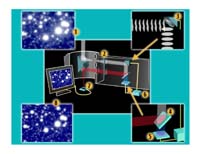


Learn more about how an adaptive optics system works. |
Whenever starlight passes through our atmosphere, it is distorted by turbulence that is similar to what we feel when traveling in an airplane. We've all seen the effects of this turbulence on stars. It's called twinkling. Because twinkling blurs images made through a telescope, scientists go to great lengths (and heights) to reduce its effects.
One of the reasons that the Hubble Space Telescope was put high above the Earth's atmosphere was to escape its adverse effects. Since putting Gemini into orbit is not an option, Gemini uses a relatively new technology called adaptive optics. Adaptive optics works simply: the system takes a sample of starlight, determines how the atmosphere bent it, and then uses a deformable mirror to "straighten" the starlight out again. Simple, right? Right, but there's a bit more to it. Because stars are so far away, starlight passing through our atmosphere consists of parallel wavefronts of light that are bent and distorted by air of different temperatures, and therefore, different densities. Because our atmosphere is constantly changing and mixing together, the effect is very random and quite dynamic. When starlight enters a telescope like Gemini, if nothing is done, the distortions caused by the atmosphere are magnified. Stars often look more like shimmering blobs than the pinpoints of light they would be if viewed from space. Before starlight passes into many of the instruments or cameras on Gemini, a representative column of starlight is diverted through a beam-splitter into what is called a "wavefront sensor." The column of light entering the wavefront sensor is a representative sample of the light that is being collected across the entire main mirror of the telescope. In other words, any distortions that are visible to the wavefront sensor correspond directly to distortions somewhere in the atmosphere above the telescope. In order to use this information, the wavefront sensor separates the column of light into many areas or zones, and samples each zone to determine how our atmosphere altered the light. By taking samples on the order of a thousand times per second, the information from the wavefront sensor is fed back to a "flexible" or deformable mirror, about the size of the palm of your hand, that can be adjusted (like a funhouse mirror) to counteract for the distortions caused by the atmosphere. However, unlike a funhouse mirror, these adjustments are very small and precise, and cannot even be seen while watching the mirror. Adaptive optics systems work best with longer wavelength light, which means that Gemini will see the most dramatic results with infrared observations. Using this system, it is expected that Gemini will produce the sharpest images yet of the infrared sky and dramatically improve many other types of observations as well. For more information about how starlight becomes distorted, click here. For more information about how a generic adaptive optics system works, click here. The razor-sharp Gemini image taken with adaptive optics is shown in the upper right of the above sequence that also includes a wide-field view of the M-13 cluster and blow-up of the core as imaged by the Canada-France-Hawaii Telescope. Below the Gemini adaptive optics image, is another image for comparison that shows the same field without adaptive optics. Notice that the starlight is much more concentrated with the adaptive optics system and produces significantly sharper images that can also detect fainter objects. Interested parties should contact Peter Michaud at the address below for a video animation of Gemini's adaptive optics system. Return to the press release. |
|
|
|
|
Learn more about wavefront optics.  |
|
|
|
|
|
|
|
|
|
|

|
|
|
|
|

|